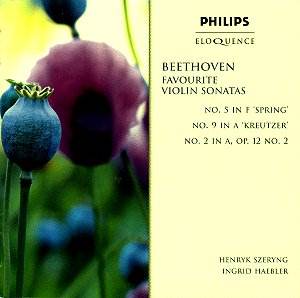Szeryng, born Henryk Serek in Warsaw in 1918, was one
of Carl Flesch’s most outstanding talents. He studied with Flesch in
Berlin from 1928-1932 but his career was slow to develop and Szeryng
ended up in the relative musical backwater of Mexico. Here, gradually,
he became a Mexico’s Cultural Ambassador of Goodwill (and on testy days
was apparently given to insisting that he be addressed as Ambassador
Szeryng). Rubinstein heard his fellow Pole and began a musical association
that led to prestigious engagements for the violinist and eventual fame.
He recorded the Spring and Kreutzer Sonatas with Rubinstein
but the performances on this disc with the estimable Ingrid Haebler
date from shortly before the violinist’s unexpectedly early death.
Szeryng was an exceptionally attractive and fluent
player. He had a vibrato of controlled subtlety, a varied tonal palette
and decorous musical impulses. In the core repertory he was invariably
elegant and impressive – in Mozart especially so – but there is sometimes
a strange "yes, but…" quality to his playing - a feeling that
technical excellence is not always accompanied by commensurate interpretative
depth. That said I enjoyed these performances. The Spring Sonata
opens languidly with accents that are brisk but not trenchant and there
is a scrupulous cleanliness to the playing that doesn’t preclude intimacy.
The slow movement is again reflective, expressive with a good range
of dynamics from the violinist whilst the rapport with Haebler is best
exemplified in the finale with their seamlessly judged control of tempo.
The Op 12 No 2 Sonata is charmingly done. There is an entirely apposite
elegance to this early work which both players never overstrain to evoke.
It was only with the Kreutzer that I had some reservations. Theirs
is not a declamatory performance but neither is it too small-scaled.
Haebler is perhaps guilty of a little staccato-legato playing in the
opening movement. Szeryng is also a little affected here, with the result
that the rhythm emerges as rather retarded. Nevertheless the violinist
doesn’t overload the piano in the Concertante passages and is properly
subservient in accompanying figures – the balance maintained is a good
one. The end of the movement is measured with no sharply etched attacking
playing. In the Andante con variazioni Haebler’s introduction
is individual but slightly vitiated by over accenting – but I like the
way that, better than many, she brings out the left hand melodies in
the variations. As I do the sheer astringency of some of Szeryng’s playing.
Recording time is good with quite reasonable notes. Recommended.
Jonathan Woolf


